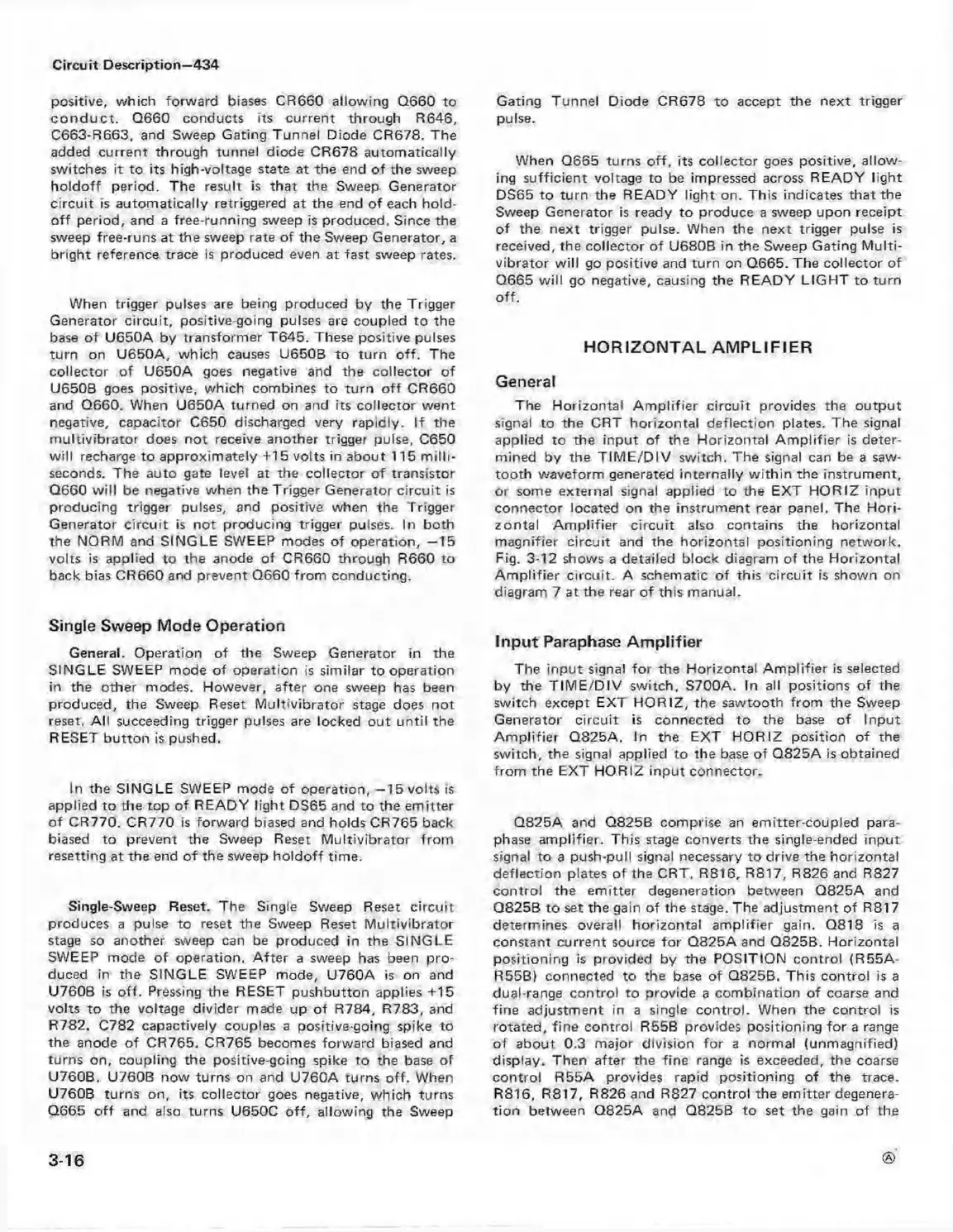Circuit Description—434
positive, which forward biases CR660 allowing Q660 to
c o n d u c t. Q660 conducts its current through R646,
C663-R663, and Sweep Gating Tunnel Diode CR678. The
added current through tunnel diode CR678 automatically
switches it to its high-voltage state at the end of the sweep
hoidoff period. The result is that the Sweep Generator
circuit is autom atically retriggered at the end of each hold-
off period, and a free-running sweep is produced. Since the
sweep free-runs at the sweep rate of the Sweep Generator, a
bright reference trace is produced even at fast sweep rates.
When trigger pulses are being produced by the Trigger
Generator circuit, positive-going pulses are coupled to the
base o f U650A by transformer T645. These positive pulses
turn on U650A, which causes U650B to turn off. The
collector of U65QA goes negative and the collector of
U650B goes positive, which combines to turn o ff CR660
and Q660. When U650A turned on and its collector went
negative, capacitor C650 discharged very rapidly. If the
m ultivibrator does not receive another trigger pulse, C650
w ill recharge to approximately +15 volts in about 115 m illi
seconds. The auto gate level at the collector of transistor
Q660 w ill be negative when the Trigger Generator circuit is
producing trigger pulses, and positive when the Trigger
Generator circuit is not producing trigger pulses. In both
the NORM and SINGLE SWEEP modes of operation, —15
volts is applied to the anode of CR660 through R660 to
back bias CR660 and prevent Q660 from conducting.
Single Sweep Mode Operation
General. Operation of the Sweep Generator in the
SINGLE SWEEP mode of operation is similar to operation
in the other modes. However, after one sweep has been
produced, the Sweep Reset M ultivibrator stage does not
reset. All succeeding trigger pulses are locked out until the
RESET button is pushed.
In the SINGLE SWEEP mode of operation, —15 volts is
applied to the top of READY light DS65 and to the em itter
of CR770. CR770 is forward biased and holds CR765 back
biased to prevent the Sweep Reset M ultivibrator from
resetting at the end o f the sweep hoidoff time.
Single-Sweep Reset. The Single Sweep Reset circuit
produces a pulse to reset the Sweep Reset M ultivibrator
stage so another sweep can be produced in the SINGLE
SWEEP mode of operation. A fter a sweep has been pro
duced in the SINGLE SWEEP mode, U760A is on and
U760B is off. Pressing the RESET pushbutton applies +15
volts to the voltage divider made up of R784, R783, and
R782. C782 capactively couples a positive-going spike to
the anode o f CR765. CR765 becomes forward biased and
turns on, coupling the positive-going spike to the base of
U760B. U760B now turns on and U760A turns off. When
U760B turns on, its collector goes negative, which turns
Q665 off and also turns U650C o ff, allowing the Sweep
Gating Tunnel Diode CR678 to accept the next trigger
pulse.
When Q665 turns off, its collector goes positive, allow
ing sufficient voltage to be impressed across READY light
DS65 to turn the READY light on. This indicates that the
Sweep Generator is ready to produce a sweep upon receipt
of the next trigger pulse. When the next trigger pulse is
received, the collector of U680B in the Sweep Gating M ulti
vibrator w ill go positive and turn on Q 665.The collector of
Q665 w ill go negative, causing the READY LIG HT to turn
off.
HORIZONTAL AMPLIFIER
General
The Horizontal A m plifier circuit provides the output
signal to the CRT horizontal deflection plates. The signal
applied to the input of the Horizontal A m plifier is deter
mined by the T IM E /D IV switch. The signal can be a saw
tooth waveform generated internally w ithin the instrument,
or some external signal applied to the EXT H ORIZ input
connector located on the instrument rear panel. The H ori
zontal Am plifier circuit also contains the horizontal
magnifier circuit and the horizontal positioning network.
Fig. 3-12 shows a detailed block diagram of the Horizontal
A m plifier circuit. A schematic of this circuit is shown on
diagram 7 at the rear of this manual.
Input Paraphase Am plifier
The input signal fo r the Horizontal A m plifier is selected
by the T IM E/D IV switch, S700A. In all positions of the
switch except EXT H ORIZ, the sawtooth from the Sweep
Generator circuit is connected to the base of Input
A m plifier Q825A. In the EXT HORIZ position of the
switch, the signal applied to the base of Q825A is obtained
from the EXT HORIZ input connector.
Q825A and Q825B comprise an emitter-coupled para
phase am plifier. This stage converts the single-ended input
signal to a push-pull signal necessary to drive the horizontal
deflection plates of the CRT. R816, R817, R826 and R827
control the em itter degeneration between Q825A and
Q825B to set the gain of the stage. The adjustment of R817
determines overall horizontal am plifier gain. Q818 is a
constant current source for Q825A and Q825B. Horizontal
positioning is provided by the POSITION control (R55A-
R55B) connected to the base of Q825B. This control is a
dual-range control to provide a com bination of coarse and
fine adjustment in a single control. When the control is
rotated, fine control R55B provides positioning for a range
of about 0.3 major division for a normal (unmagnified)
display. Then after the fine range is exceeded, the coarse
control R55A provides rapid positioning of the trace.
R816, R817, R826 and R827 control the em itter degenera
tion between Q825A and Q825B to set the gain of the
@
3-16

